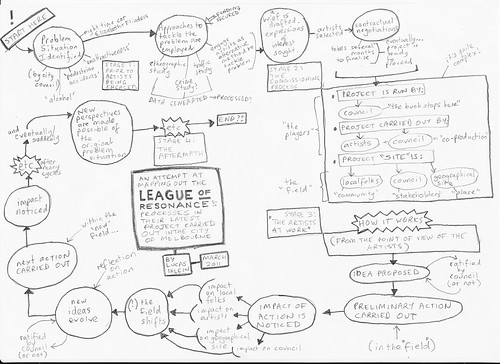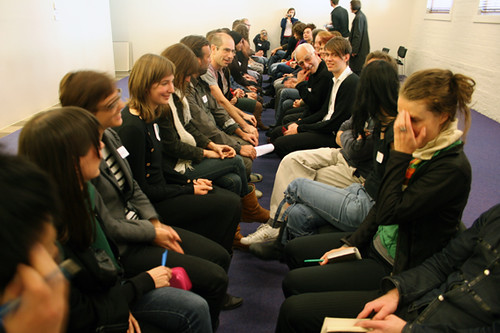This week I was invited to participate in a one day public forum entitled “Live Art, Social & Community Engagement: Methodologies of Practice” at UNSW, convened by Stephanie Springger and Lenine Bourke.
Here’s how it worked:
In the morning, 5 artists gave brief presentations addressing key questions about the ethics and aesthetics of socially engaged art, community art, etc (the naming of these practices was also in question).
These artists were Leuli Eshragi, Latai Taumoepeau, Rosie Dennis, Cigdem Aydemir, and Lauren Booker, and their presentations were moderated by Francis Maravillas.
After lunch, each of the speakers was teamed up with a “live writer”. The live writers included Jennifer Hamilton, Rebecca Conroy, Keg de Souza, Astrid Lorange, and Lucas Ihlein. About 40 people were in attendance – from what I could gather, mainly artists, students, and curators. Around each pairing of speaker + live writer there was a breakout group to flesh out some of the salient points from the morning’s discussion.
The speaker led the small workshop discussion and the live writer used whatever method s/he felt most useful to map, transcribe, document etc what went on in the discussion. I was teamed up with Latai Taumoepeau, and our allocated theme was “class, negotiation and power”.
Many times in these kinds of events, I’ve used diagrams and mindmaps as a tool to make sense of the complexity of the discussion. However, this time I decided to try something different, proposing to use the Haiku form as a way to engage in live writing.
My previous experience with Haiku is minimal. I’m a fan of the great Japanese Haiku-ist Basho, and his “Oku no Hosomichi” aka “Narrow Road to the Deep North“. And I enjoyed John Cage’s translation of Basho’s Mushroom Haiku.
On the train up to the forum, I listened to a podcast I found by googling “socially engaged art” and “haiku”. It was by John Paul Lederach, and it was called “The Art of Haiku and the Soul of Peacebuilding”. Lederach is a “peacebuilder” who sometimes travels to places of deep conflict, and sits down with people to assist with the reconciliation process. In his talk, he says that he sometimes finds the Haiku form useful in crystallising complex ideas without requiring closure.
I found Lederach’s ideas inspiring, particularly his thoughts on the relationship between complexity and simplicity. He quotes a poem from Oliver Wendal Holmes Jnr:
I would not give a fig for the simplicity on this side of complexity
But I would give my life for the simplicity on the other side of complexity.
I found this interesting – often in my mindmaps and diagrams, I create an image of complexity. The graphic squiggles and vector lines are sometimes useful in explaining the intractable stuckness of a complex multi-stakeholder situation. But the Haiku has the potential to travel through this complexity “to the other side”.
What, Lederach asks, is simplicity on the other side of complexity? It’s a way of “finding the essence, while holding the complexity, and living into places that we don’t fully understand”. For Lederach, the Haiku can be a way of doing this. If the diagram breaks things down, the Haiku is about putting things together. He describes how sometimes he is able to practice a form of deep attentive listening at multi-party negotiations, where different positions are at odds with one another. At some point in the proceedings, somebody will say something which seems to rise with clarity from all the words. The Haiku at this moment writes itself. Then Lederach, when the time is right, reads the Haiku back to the group – and this is sometimes able to catalyse a deeper understanding within the group of the current dynamics of the relationship.
Back to the present. In our group discussion there were five of us: Latai, Pedro, Stella, Pippa and I. Francis and Stephanie also popped in briefly at different points. We didn’t even try to stick to the assigned subject of “class, negotiation and power”. If these issues were addressed it was part of an organic evolving conversation which was warm, probably assisted by the fact that there were only 5 of us.
Latai began by talking about some performances she has been doing – with fake spray-tan (at Gallery 4A in Sydney) and with white zinc cream (at the Hong Kong Basel Art Fair). She spoke about her choices of these darkening and lightening agents and their culturally specific meanings. While she spoke, I wrote my first haiku. A bit overwrought, but you’ve got to start somewhere:
What is light on one
Background can become very
dark on another.
While working on her spray-tan project, Latai had struck up a friendship with the proprietor of one particular company, “Black Magic”, who was so intrigued he decided to become a sponsor of the project:
Black Magic Spray Tan
Application by machine:
Darker and Darker.
Continuing her exploration of cultural identity and skin coloration, Latai told us how back in Tonga where she is “from”, her family members criticised her for being “too dark”. Perhaps it was the residue from her Spray Tan performance that made her darker, I can’t remember. Whatever the reason, her darker skin was regarded as being at odds with her privileged social status in the local community. Dark skin is associated with labourers and agricultural workers:
Skin colour darkens.
Relatives chastise me for
shellfishing all day.
Our conversation shifted to the Hong Kong Art Fair version of the work, where she used white zinc cream instead of spray tan – partly because of health and safety issues (the spray machine was not considered acceptable for the atmosphere of the indoor art fair environment). Latai didn’t know how to prepare for interacting with people in this strange setting:
Art fair audience:
How do they read all this stuff
Out of its context?
The audience for her work, Latai said, often shapes the kinds of performances she does. Sometimes, as a Pacific Islander, she receives invitations to perform in public under what she feels is an “anthropological gaze”. In these situations, she responds by performing unexpectedly – not merely doing a “nice ethnic dance”, but rolling herself up in long sheets of ceremonial cloth, writhing around, unravelling herself and
Fucking with my own
Material Culture. Fuck
Anthropologists!
At this point in the workshop, the other members of our group introduced ourselves. Stella, an artist and a recent masters graduate, is originally from Taiwan. In Taiwan, she told us, children are given English names. They do not get to choose. She was allocated “Betty”:
Taiwanese Betty.
Names distributed by force:
Betty for three years.
After three years, “Betty” decided to take the power back:
Recolonising
My own name. I choose Stella:
New identity.
Stella goes on:
Shared language shapes our
Collective memory. We
Can decolonise!
In her discussion of Taiwan, Stella mentions its other name: Formosa. I asked her about where that name came from, and what it means:
“Beautiful Island”.
Portuguese passing by shout
Out “Formosa Ho!”
Pippa, who works with the company Performing Lines, told us how she’d been in the UK for 14 years. She loves the context of “community art”, despite the fact that as a category of practice, it has been marginalised by the mainstream contemporary art world (this had been one of the contentious issues to come up in the plenary session of the morning):
Community Art.
Proudly looked down upon by
Snobbish Avant-Garde.
Pippa also made a strong case for consistency of language. She urged us to align the words we use in funding applications with the words we might use “on the ground” while doing community engaged projects. Too often, she said,
Funding proposals
Become marketing copy:
Bewildered people.
Pippa also argued that thousands of useful dollars get swallowed up when organisations have to pay large rents, and proposed that government funding should not be able to be spent on real estate:
Money should go to
People and Artists and not
To Bricks and Mortar.
This led to a discussion about how so many arts workers are chronically underpaid: clearly not a good thing. On the other hand, working beyond remuneration can sometimes generate more joy, because the time spent is not associated with a “job” and its demands for measurable outcomes. Questions arise:
Volunteerism:
Pleasure or exploitation?
And sub-contracting?
Pedro, who words for 4A Centre for Contemporary Art, had a lot to say about all of this. One of his main questions to me was about how as an artist I deal with the power and influence of the institution (in my case, embodied by my job at a university). It’s not an easy problem to negotiate – because when I’m embedded within an institution, potential projects tend to rise to the top of the pile only when they attract funding (whereas in my pre-institutionalised past I would have just done them “for free”). My response:
Institutional-
isation is a virus:
How to immunise?



